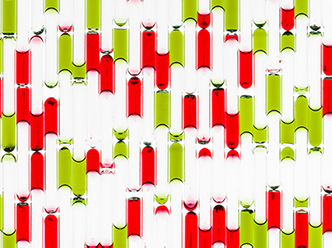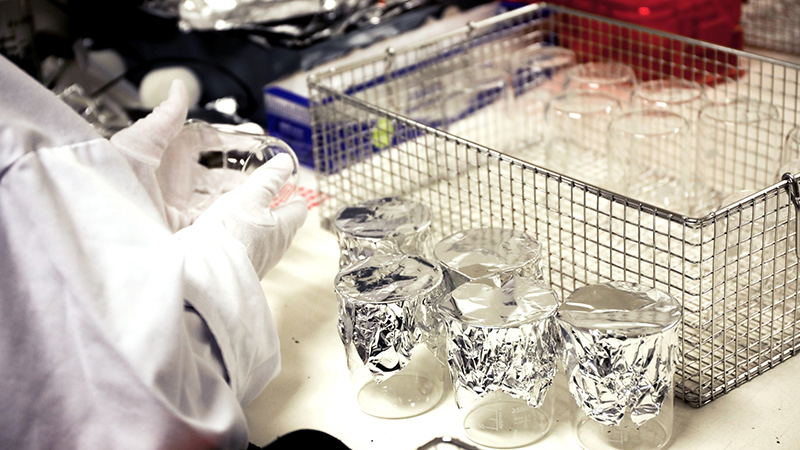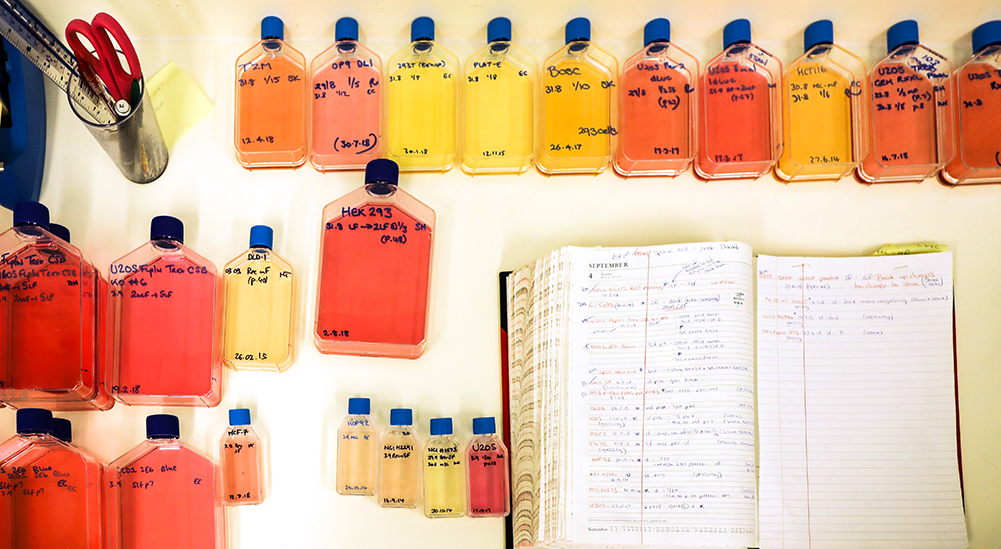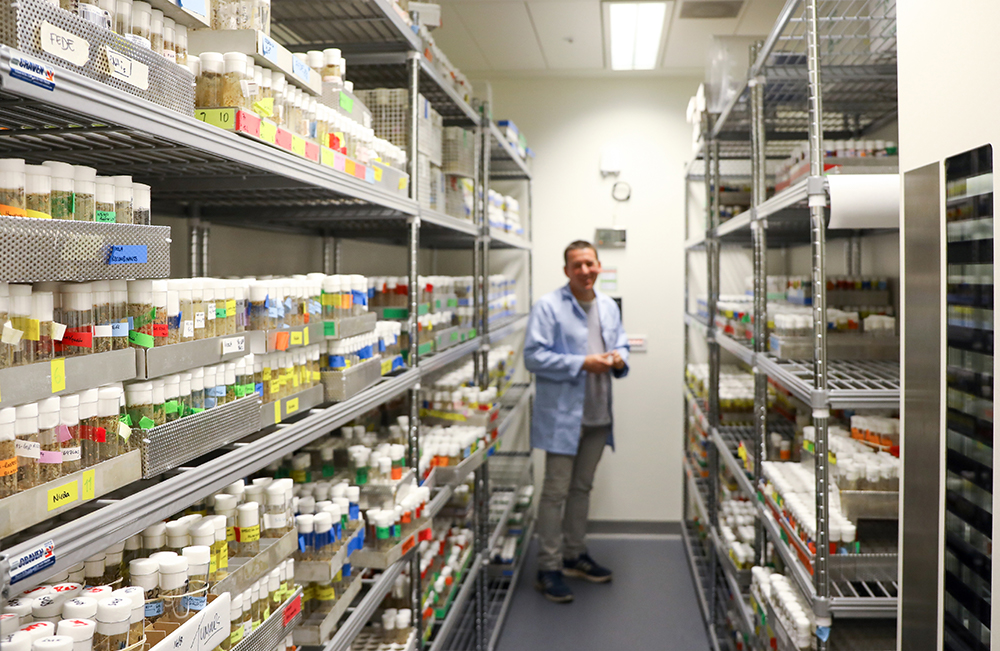Behind the scenes at the laboratory Inspire article
You don’t have to be a researcher to take part in worthwhile scientific research. Find out about some of the less visible roles that keep the science happening.

temperature in the glass
wash facility at the Francis
Crick Institute
SNDA Ltd
Although many students are enthusiastic about studying science at school, it’s not a universal sentiment: some less-enamoured students sometimes question why they need to learn about science when they are not ultimately aiming for a career as a researcher. One answer, of course, is that scientific knowledge helps us to understand key issues facing society – from future energy sources to regulating gene technology – as well as to make more evidence-based choices in our own lives.
But there is another reason, which is sometimes overlooked: science can offer great job opportunities, even for those who are not aiming for a future as a research scientist.
A current exhibition at one of Europe’s biggest and newest laboratories aims to remind people of this fact. ‘Craft and Graft’w1 takes a look behind the scenes at the many different teams that support the biomedical research carried out at the Francis Crick Institute in London – from bottle-washing to breeding flies. Each of these teams employs staff who need to be 100% reliable in what they do, because the research absolutely requires this: a non-sterile flask, for example, could ruin a year’s work.
The curator of the exhibition, Emily Scott-Dearing, worked for a year to create ‘Craft and Graft’ and spoke to members of some 20 different technician teams who maintain the vital services needed for the laboratory’s research. “You certainly don’t have to be a scientist to play a part in life-changing scientific research. There are so many routes into this world”, Emily says.
More than washing up

freshly washed glassware
SNDA Ltd
Among the technicians that support the science are the glass wash team, who provide fresh glassware throughout the building. Each member of the team is responsible for collecting, cleaning and returning glassware to a particular group of laboratories. This means running some 20 loads through industrial dishwashers every day, oven-baking or autoclaving the items to sterilise them – and clocking up a lot of steps to pick them up and return them. Over a year, the team cleans around 750 000 flasks, test tubes and beakers.
Attention to detail is essential throughout – perhaps even more than when looking after crystal glasses in a fine-dining restaurant. And, as Emily says, “Would you rather wash glasses in a restaurant or wash the flasks and bottles crucial for cancer research and understanding how our brains work?”
Like many members of the team, Nick Sherwood trained on the job. With school-level science qualifications and a background in practical work, Nick has been a glass wash technician since 2006. “Our roles are so different from the scientists’”, he says. “But when you see the work they’re doing, you feel part of a whole.”
Cells – fresh and frozen
In a biomedical laboratory, cells are the living systems that many scientists use as biological models for their experiments. These ‘cell lines’ – cells that can reproduce indefinitely – have to be cultured and then frozen for storage in the cell line repository.
Technicians in the cell services team look after around 100 different cell types at any one time – with another 6000 types hibernating in basement freezers. This amounts to culturing billons of cells each year for use in cancer studies and other biomedical research, as the researchers require.

SNDA Ltd
Cell services team member Fatemeh Abolverdi arrived at her post as a laboratory research apprentice after studying science at school, followed by a college diploma in applied science. As well as culturing cells and retrieving them from liquid nitrogen, she needs to observe correct laboratory procedure at all times in her role. As Fatemeh says, “The quality of cells that cell services provides to scientists can have far-reaching effects and impacts on experiments.” The work often entails multitasking and working under pressure, while maintaining meticulous records. But Fatemeh takes this in her stride: “I enjoy everything in cell services”, she says.
Fruitful flies
As biomedical research advances, the tiny fruit fly Drosophila remains a key model organism used by biomedical researchers – not least because 70% of genes linked to human disease have a fruit-fly equivalent. The fly facility at the Francis Crick Institute looks after 1.5 million flies from 8000 different strains of Drosophila. Feeding these flies consumes some 10 000 litres of food per year – but the fly facility team does a great deal more than provide bed and board for their insect residents. Staff are also skilled in providing the technical services researchers need, including performing microinjection procedures to create transgenic flies, carrying out genetic crosses, and setting up fly cages to run experiments – as well as undertaking the delicate task of identifying the sex of individual flies.
Like her colleagues in other teams, fly facility technician Grace Davis is inspired by the ultimate aim of the laboratory’s work, which she shares with the researchers. “The most satisfying aspect of working at the Crick is knowing what I do could help researchers now, or in the future, discover cures for disease”, she says.

SNDA Ltd
All in a career
All this hard work does not go unnoticed by the laboratory’s high-profile director, Nobel prizewinner Sir Paul Nurse. “Engineers, technicians and other research specialists make up a significant part of our workforce, and without them the science we do here would be impossible”, he says. And this view comes not only from his current position, but from much earlier personal experience: “I began my scientific career as a 17-year-old laboratory technician, so I really understand what technical staff contribute to research”, he says.
Web References
- w1 – Find out more about the Craft and Graft exhibition at the Francis Crick Institute in London, which runs until 30 November 2019.
Resources
- Read the Science in School interview with Sir Paul Nurse. See:
- Gristwood A (2017) The importance of failure: interview with Paul Nurse. Science in School 40: 31-33.





